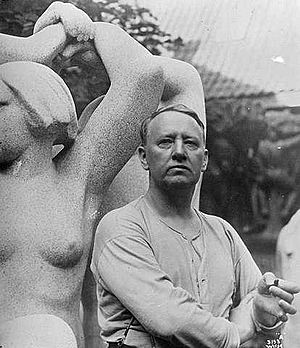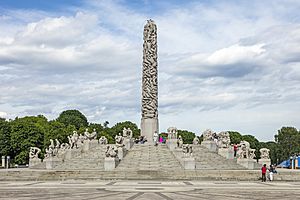Gustav Vigeland facts for kids
Quick facts for kids
Gustav Vigeland
|
|
|---|---|
 |
|
| Born |
Adolf Gustav Thorsen
April 11, 1869 |
| Died | March 12, 1943 (aged 73) |
| Nationality | Norwegian |
| Known for | Sculpture |
Gustav Vigeland (born Adolf Gustav Thorsen on April 11, 1869 – died March 12, 1943) was a famous Norwegian sculptor. He is best known for creating the amazing Vigeland installation in Frogner Park, located in Oslo. Vigeland also designed the medal for the Nobel Peace Prize. He was a very creative and productive artist.
Contents
Early Life of Gustav Vigeland
Gustav Vigeland was born Adolf Gustav Thorsen near Mandal, in a family of skilled craftspeople. His father, Elesæus Thorsen, was a cabinetmaker. His mother was Anne Aanensdatter. Gustav had three brothers, and one of them, Emanuel Vigeland, also became a well-known artist.
When he was young, Gustav went to Oslo to learn wood carving. But his father suddenly passed away, so Gustav had to go back home to help his family. For a while, he lived with his grandparents on a farm called Mjunebrokka. This farm was in a place called Vigeland. Later, he chose this name as his new family name.
In 1888, Gustav returned to Oslo. He was determined to become a professional sculptor. He met sculptor Brynjulf Bergslien, who helped him learn and practice. The next year, Gustav showed his first artwork, Hagar and Ishmael.
Travels and Artistic Growth
From 1891 to 1896, Vigeland traveled a lot. He visited cities like Copenhagen, Paris, Berlin, and Florence. In Paris, he spent time at the workshop of famous sculptor Auguste Rodin. In Italy, he studied old Renaissance artworks.
During these trips, Vigeland started to focus on themes that would become important in his art. These included ideas about death and the connections between men and women. He held his first art shows in Norway in 1894 and 1896. Critics praised his work.
Early Public Art Projects
Until 1902, Vigeland worked on restoring the Nidaros Cathedral in Trondheim. Working with Mediaeval art inspired him to use the dragon in his sculptures. For him, the dragon represented both sin and a powerful force of nature.
Back in Oslo, the city gave him an old studio to work in. In 1905, Norway became independent from Sweden. Vigeland was seen as Norway's most talented sculptor. He received many requests to create statues and busts of famous Norwegians. These included writer Henrik Ibsen and mathematician Niels Henrik Abel.
The Fountain Project
In 1906, Vigeland suggested a large fountain design. The city of Oslo first wanted to place it in Eidsvolls plass, a square in front of the Parliament of Norway. People generally liked his design. However, there was a disagreement about where to put it. This delay meant the project was put on hold.
While waiting, Vigeland made his design even bigger. He added more groups of sculptures. In 1919, he added a tall granite column to the plan. This column would later become the famous Monolith.
The Vigeland Installation

Gustav Vigeland is most famous for the Vigeland installation. This is a huge collection of sculptures permanently displayed in Frogner Park in Oslo.
In 1921, the City of Oslo decided to tear down Vigeland's home to build a library. After much discussion, the city gave Vigeland a new building. This building would be his home and studio. In return, Vigeland promised to give all his future artworks to the city. This included his sculptures, drawings, and models.
Vigeland moved to his new studio in 1924. It was located near Frogner Park. He had chosen this park as the final home for his fountain project. For the next twenty years, Vigeland worked on creating an outdoor exhibition of his art. This became known as the Vigeland Sculpture Arrangement.
The Vigeland installation has 212 sculptures made of bronze and granite. All of them were designed by Gustav Vigeland. The most famous part is the Monolith (Monolitten). It is a tall stone column with 121 figures carved into it. These figures seem to be struggling to reach the top.
Vigeland Museum
Vigeland lived and worked in his studio until he passed away in 1943. His ashes are kept there in the building's belfry. Because of his agreement with the City of Oslo, the building became the Vigeland Museum (Vigelandsmuseet).
The museum is located just south of the Vigeland Sculpture Arrangement. Vigeland's apartment on the third floor has been kept as part of the museum. The museum displays many of his artworks. It also has the plaster models that were used to create the sculptures in Frogner Park.
See also
 In Spanish: Gustav Vigeland para niños
In Spanish: Gustav Vigeland para niños


